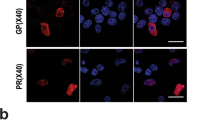Abstract
Heparan sulfate (HS)-containing, S-nitrosylated (SNO) glypican-1 (Gpc-1) releases anhydromannose-containing HS (anMan-HS) by SNO-catalyzed autodegradation in endosomes. Transport of anMan-HS to the nucleus requires processing of the amyloid precursor protein (APP) to amyloid beta peptides (Aβ). To further examine the relationship between APP and Gpc-1 processing in normal fibroblasts we have suppressed Gpc-1 autodegradation by aminoguanidine inhibition of NO synthesis and prevented lysosomal degradation of anMan-HS by using chloroquine. Deconvolution immunofluorescence microscopy and SDS-PAGE using anMan- and APP/Aβ-specific antibodies and markers for nuclei and autophagosomes were used to identify subcellular localization of Aβ and its oligomeric state. Wild-type mouse embryonic fibroblasts (WT MEF) grown during NO-deprivation accumulated 95–98 % of Aβ as oligomers in the nucleus. WT MEF treated with chloroquine accumulated both anMan-HS and Aβ, first in the nucleus then in autophagosomes. Maximal nuclear anMan-HS and Aβ accumulation was obtained after 4 and 7 h of growth, respectively. Both yielded similar banding patterns on SDS-PAGE which were also similar to the Aβ oligomers obtained after NO-deprivation. Nuclear Aβ accumulation was marginally increased (from 54 to 58 %) by suppression of both release and degradation of anMan-HS. Nuclear exit of Aβ, accumulated during growth in aminoguanidine, was enhanced by ascorbate-induced reactivation of anMan-HS production. Transgenic Alzheimer disease mouse (Tg2576) MEF, which produces excess amount of Aβ was used for comparison. Overall, nuclear Aβ exit and lysosomal degradation was compromised by inhibition of the autophagosome-lysosome pathway in both WT and Tg2576 MEF, while only WT MEF was sensitive to suppression of Gpc-1 autodegradation.






Similar content being viewed by others
Abbreviations
- AD:
-
Alzheimer’s disease
- Aβ:
-
Amyloid beta
- anMan/AM:
-
Anhydromannose
- APP:
-
Amyloid precursor protein
- CTF:
-
C-terminal fragment
- DAPI:
-
4,6-diamidino-2-phenylindole
- Gpc-1:
-
Glypican-1
- HS:
-
Heparan sulfate
- mAb:
-
Monoclonal antibody
- MEF:
-
Mouse embryonic fibroblast
- NO:
-
Nitric oxide
- pAb:
-
Polyclonal antibody
- SNO:
-
S-nitrosothiol
- Tg2576:
-
Transgenic Alzheimer disease mouse
- WT:
-
Wild-type
References
Fransson, L.-Å., Belting, M., Cheng, F., Jönsson, M., Mani, K., Sandgren, S.: Novel aspects of glypican glycobiology. Cell. Mol. Life Sci. 61, 1016–1024 (2004)
O’Brien, R.J., Wong, P.C.: Amyloid precursor protein processing and Alzheimer’s disease. Annu. Rev. Neurosci. 34, 185–204 (2011)
Williamson, T.G., Mok, S.S., Henry, A., Cappai, R., Lander, A.D., Nurcombe, V., Beyreuther, K., Masters, C.L., Small, D.H.: Secreted glypican binds to the amyloid precursor protein of Alzheimer’s disease (APP) and inhibits APP-induced neurite outgrowth. J. Biol. Chem. 271, 31215–31221 (1996)
Cappai, R., Cheng, F., Ciccotosto, G.D., Needham, B.E., Masters, C.L., Multhaup, G., Fransson, L.-Å., Mani, K.: The amyloid precursor protein (APP) of Alzheimer disease and its paralog, APLP2, modulate the Cu/Zn-nitric oxide-catalyzed degradation of glypican-1 heparan sulfate in vivo. J. Biol. Chem. 280, 13913–13920 (2005)
Cheng, F., Svensson, G., Fransson, L.-Å., Mani, K.: Non-conserved, S-nitrosylated cysteines in glypican-1 react with N-unsubstituted glucosamines in heparan sulfate and catalyze deaminative cleavage. Glycobiology 22, 1480–1486 (2012)
Mani, K., Cheng, F., Fransson, L.-Å.: Constitutive and vitamin C-induced, NO- catalyzed release of heparan sulfate from recycling glypican-1 in late endosomes. Glycobiology 16, 1251–1261 (2006)
Fransson, L.-Å., Mani, K.: Novel aspects of vitamin C: how important is glypican-1 recycling. Trends Mol. Med. 13, 143–149 (2007)
Cheng, F., Cappai, R., Ciccotosto, G.D., Svensson, G., Multhaup, G., Fransson, L.-Å., Mani, K.: Suppression of amyloid β A11 antibody immunoreactivity by vitamin C. Possible role of heparan sulfate oligosaccharides derived from glypican- 1 by ascorbate-induced, nitric oxide (NO)-catalyzed degradation. J. Biol. Chem. 286, 27559–27572 (2011)
Cheng, F., Cappai, R., Lidfeldt, J., Belting, M., Fransson, L.-Å., Mani, K.: APP/APLP2 expression is required to initiate endosome-nucleus-autophagosome trafficking of glypican-1-derived heparan sulfate. J. Biol. Chem. 289, 20871–20878 (2014)
Cheng, F., Fransson, L.-Å., Mani, K.: Rapid nuclear transit and impaired degradation of amyloid beta and glypican-1-derived heparan sulfate in Tg2576 mouse fibroblasts. Glycobiology 25, 548–556 (2015)
Cheng, F., Ruscher, K., Fransson, L.-Å., Mani, K.: Non-toxic amyloid beta formed in the presence of glypican-1 or its deaminatively generated heparan sulfate degradation products. Glycobiology 23, 1510–1519 (2013)
Barucker, C., Harmeier, A., Weiske, J., Fauler, B., Albring, K.F., Prokop, S., Hildebrand, P., Lurz, R., Heppner, F.L., Huber, O., Multhaup, G.: Nuclear translocation uncovers the amyloid peptide Aβ42 as a regulator of gene transcription. J. Biol. Chem. 289, 20182–20191 (2014)
Stewart, M.D., Sanderson, R.D.: Heparan sulfate in the nucleus and its control of cellular functions. Matrix Biol. 35C, 56–59 (2014)
Nixon, R.A.: The role of autophagy in neurodegenerative disease. Nat. Med. 19, 983–997 (2013)
Nixon, R.A.: Alzheimer neurodegeneration, autophagy, and Abeta secretion: The ins and outs. Bioessays 36, 547 (2014)
Nilsson, P., Saido, T.C.: Dual roles for autophagy: degradation and secretion of Alzheimer’s disease Aβ peptide. Bioessays 36, 570–578 (2014)
Benilova, I., Karran, E., De Strooper, B.: The toxic Aβ oligomer and Alzheimer’s disease: an emperor in need of clothes. Nat. Neurosci. 15, 349–357 (2012)
Kagan, B.L.: Membrane pores in the pathogenesis of neurodegenerative disease. Prog. Mol. Biol. Transl. Sci. 107, 295–325 (2012)
Prangkio, P., Yusko, E.C., Sept, D., Yang, J., Mayer, M.: Multivariate analysis of amyloid-beta oligomer populations indicate a connection between pore formation and cytotoxicity. PLoS One 7, e47261 (2012)
Acknowledgments
This work was supported by grants from the Swedish Research Council, the Swedish Cancer Society, Alfred Österlund, Kock, Åhlen, Stohnes, Längmanska kulturfond, Gamla Tjänarinnor, and Olle Engkvist Foundations.
Author information
Authors and Affiliations
Corresponding author
Electronic supplementary material
Below is the link to the electronic supplementary material.
ESM 1
(PDF 91 kb)
Rights and permissions
About this article
Cite this article
Cheng, F., Fransson, LÅ. & Mani, K. Suppression of glypican-1 autodegradation by NO-deprivation correlates with nuclear accumulation of amyloid beta in normal fibroblasts. Glycoconj J 32, 675–684 (2015). https://doi.org/10.1007/s10719-015-9616-4
Received:
Revised:
Accepted:
Published:
Issue Date:
DOI: https://doi.org/10.1007/s10719-015-9616-4




